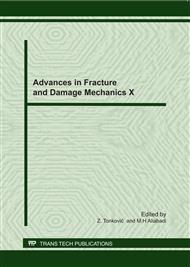p.113
p.117
p.122
p.126
p.130
p.134
p.138
p.142
p.146
Modelling of Crack Bifurcation in Laminar Ceramics with Large Compressive Stress
Abstract:
Ceramic laminates designed with strong interfaces have shown crack growth resistance (R-curve) behaviour through microstructural design (e.g. grain size, layer composition) and/or due to the presence of compressive residual stresses, acting as a barrier to crack propagation. The goal of the contribution is to model the mechanism of crack bifurcation in laminar ceramics with large compressive stress which still have not been satisfactory explained. Experimental observations of the crack path in the multilayered ceramics tested under several kinds of loading showed crack penetration (i.e. crack propagating normal to the layers followed by crack bifurcation when the crack propagated from the tensile to the compressive layer. Numerical results [1] show that the initiation of crack bifurcation can be explained by the near-tip J-integral, provided that micro-cracks exist near the crack tip. We revisit the problem using the concept of Finite fracture mechanics and the matched asymptotic expansion method in order to evaluate the energy release rate criteria describing the competition of the crack bifurcation and straight crack propagation near behind the bimaterial interface.
Info:
Periodical:
Pages:
130-133
Citation:
Online since:
September 2011
Authors:
Price:
Сopyright:
© 2012 Trans Tech Publications Ltd. All Rights Reserved
Share:
Citation:


